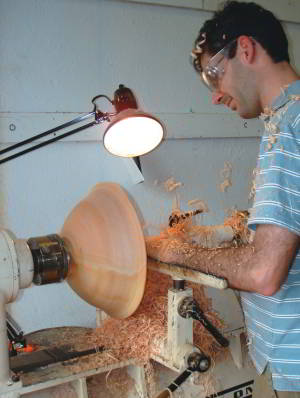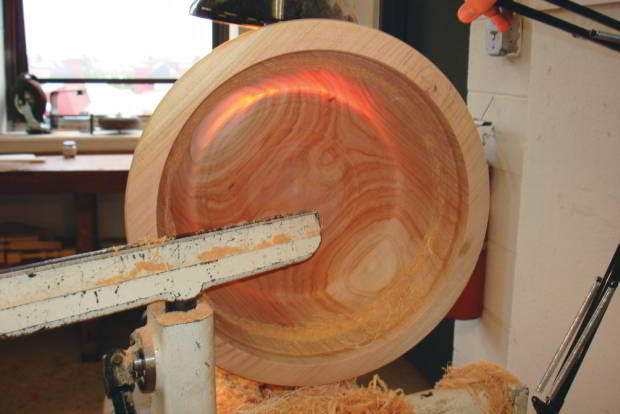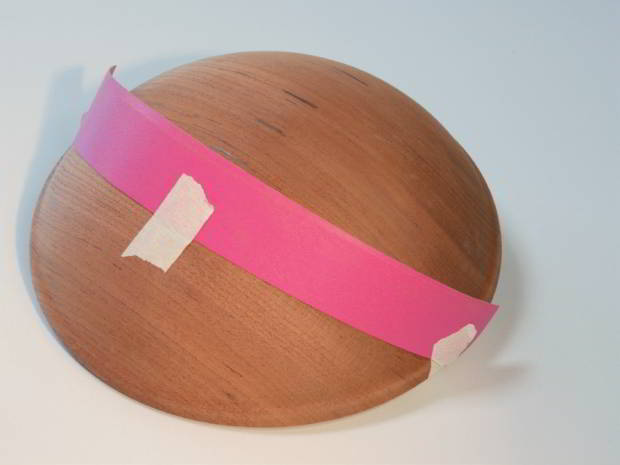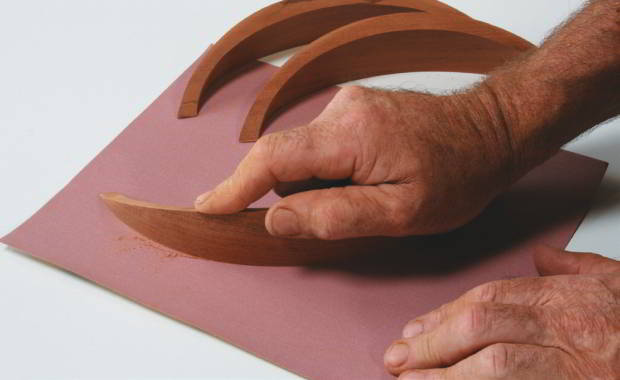Inspiration for art pieces can usually be tracked to something you may have seen or thought about for a long time and this design is really no different.
In 2006 I was involved in the International Woodturning Exchange in Philadelphia, USA. This is an eight week program which brings together five wood artists, a writer and a journalist to share ideas and to work collaboratively.
The journalist in our group, Dennis Carr, wanted to learn how to turn so I helped him along. Just as he was finishing the inside of the maple bowl shown in photo 1, I was called away to the phone. I asked one of the other woodturners to keep an eye on him while I was gone.
When I came back everyone was laughing, and when I looked at the bowl I saw why. As shown in photo 2, it had become rather thin in places.
We parted off the top section and put it aside on one of the benches, where it sat for about five weeks. When a member of the group later asked me to make a bowl for a display, I came up with the idea of cutting and rejoining the top of Dennis’s bowl into a bowl like the one shown above left.
For this story I turned a bowl in red cedar and reconfigured it into two forms, one with segments A and E pinned and glued together like the maple bowl, plus another one with segments B, C and D connected by pins (see diagrams below).
Paperwork
I find it best to develop ideas on paper before I move onto a prototype.
On a semicircular schematic (fig.1) I worked out how sections A and E would join to give a continuous radius rather than a point. I had to think about how the piece would sit on a plinth or table.


Dennis Carr turns a large maple bowl ...oops, it got a bit thin in places!
If it was cut too close to the rim it would join with a raised section inside. If it was cut too far from the rim it would join in a V rather than a continuous curve.
Start the cut line on the rim flat about 6mm either side of the centre mark. A 45° angle should be right but you should check by cutting up and reassembling the paper pattern (make a few photocopies to practise on).
If your A and E sections join as in fig.2 you have the correct angle. If the paper joins with a pointed shape then you need to have a smaller angle than 45° (cut closer to the rim). If it joins with a inner curve then you need to cut further away from the rim. The segments for the pinned bowl will join as in fig.3.
When you have sorted out the angles you cut a 250mm dia x 90mm deep blank to turn the bowl that will be cut and reassembled.

Turn the bowl
Attach the top of the bowl blank to a screw centre held in a chuck.

Photo 3: Attaching the top of the bowl on a screw centre.
Use a bowl gouge rolled over on its side with the flute pointing away from the bowl so that you cut with the bottom half of the gouge, rubbing the bevel behind the cut.

Photo 4: Turning the outside of the bowl using a 13mm deep fluted gouge.
Shape the outside of the bowl into a hemisphere and turn a temporary foot to suit a scroll chuck. The rim should protrude about 2mm outside the wall as in fig.1.
Sand the outside to about 320 grit—power sanding saves time.

Photo 5: Power sanding the outside.
Reverse the bowl and hold the temporary foot in the chuck to turn the inside. Roll the gouge onto its side with the flute pointing away from you so you are still cutting with the bottom half of the gouge.

Photo 6: Turning the inside of the bowl with the same deep fluted gouge.
Turn the inside to a wall thickness of 9–10mm. The walls need to be fairly thick so we can drill holes in them later. Check the thickness with double-ended or spring calipers.

Photo 7: Checking the wall thickness of the bowl with spring calipers.
I left the rim about 12mm thick as I planned to decorate it.
Now power sand the inside to 320 grit.
To remove the temporary foot, you’ll need to turn a mandrel to fit inside the bowl. The mandrel sits in the chuck and a small piece of soft 3mm thick rubber sits between it and the bowl.
Secure the middle of the foot with the tailstock centre.

Photo 8: Placing the bowl over a mandrel to turn off the foot.
Turn off the temporary foot leaving a 12mm spigot which is removed with a carving gouge.

Photo 9: The foot is almost turned off.
It is worth making a special bench hook with padded surfaces like the one shown in photo 10 for doing this process so that your bowls are protected and your hands are out of the way of sharp gouges.

Photo 10: Removing the remaining spigot. Note how to hold the workpiece safely.
Cut the segments
Transfer the two outer lines from fig.1 using a piece of flexible plastic strip.

Photo 11: Flexible strip of plastic to mark cutting lines.
Tilt the bandsaw table as shown in photo 12 to cut segments A and E.

Photo 12: Tilt the bandsaw table to cut the two outside curves.
Cleaning up the cuts on a disc sander was easy.

Photo 13: Sanding the cut surface level on a disc sander.
Mark segments B, C and D using the plastic strip again. It was easier to cut these from the inside.

Photo 14: Cutting segments B, C and D.
Sand again on the disc sander, checking the sections are even in length.
Fine sand the cuts by rubbing them over 180 and then 320 grit abrasive sheets on a flat surface.

Photo 15: Fine sanding the edges after disc sanding.
The glued bowl
To join segments A and E I hammered in three 15mm panel pins about half way in on one side, then cut off the head so 2mm was left protruding.

Photo 16: Drilling the holes for the pins.

Photo 17: Segments A and B are ready to be glued with cut off pins.
This stopped the pieces sliding when they were glued and clamped in a vice.

Photo 18: Clamping segments A and B.
Once the glue is dry you can fine sand the join and all the surfaces.
The pinned bowl
I marked a centre line on the edge of sections B, C and D and then marked where to drill 5 x 3mm holes for the stainless steel pins.
The outer pins are 25mm from the ends and the others are evenly spaced using vernier calipers so the marks would line up.
Set up a stop on the drill to get correct depth for each hole (photo 16). Cut the pins to correct length and roughen the section that will be inside the hole so the glue sticks better.
The length of the pins is 8mm plus the depth of the two holes (fig.3). You could use brass pins or even turn some contrasting timber ones if you prefer.
Fine sand all the surfaces then apply epoxy resin in the holes and assemble the sections. You shouldn’t need to clamp them, but if you do you could just use electrical tape.
Decoration
I thought the pinned bowl was bold enough with the contrast of the darker red cedar and stainless steel so I elected not to over-power it with more decoration.
The other bowl seemed a bit plain so I carved a small V and then used a pyrography tool to stipple burn the raised section of the rim.

Photo 19: Stipple burning a design on the top section.
Both bowls were oil finished.
Conclusion
What have I learned from this process? I think it shows you that you can think your way creatively out of mistakes instead of being defeated by them.
Michael Hosaluk, the well known woodworker from Canada, has been quoted saying ‘There is no such thing as a mistake, only a design opportunity’.
Photos: Neil Scobie
Neil Scobie is a furniture designer/maker and wood artist who lives in Lower Bucca, NSW. Neil also teaches woodwork in his home-based workshop.
Email: nlscobie@bigpond.com
























